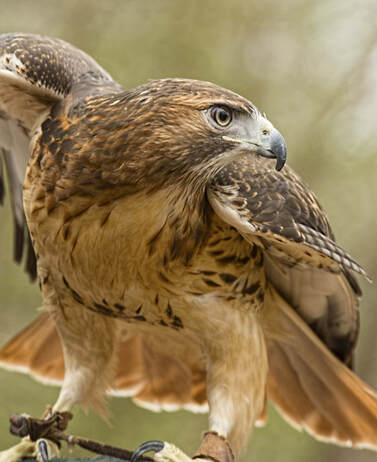Eastern Red-Tailed Hawk (Buteo jamaicensis borealis)

Physical Description: Eastern Red-Tailed Hawks are large raptors with very broad, rounded wings, a hooked beak, and a short, wide tail. They are generally covered in brown feathers that vary from dark brown to a light, reddish color on the upper side. Their underside is typically pale or cream colored, with darker streaks on the belly and chest. The tail feathers are typically a brownish red, giving this hawk its name. This coloration displayed by the hawk, light on bottom and dark on top, is a type of camouflage called countershading. The Eastern Red-Tailed Hawk’s feet are bare of feathers, and they are powerful and equipped with sharp talons, the undersides of the toes are padded. They have a 1 ½ to 2 feet long with a wingspan of 4 feet and weigh 1 ½ to 3 ¼ pounds, with females larger than males.
Eastern Red-Tailed Hawks have an upper and lower eyelid similar to humans, but they also have a third, clear eyelid that closes from the side. This third eyelid is called a nictitating membrane and is used for lubrication typically associated with blinking as well as for protection when hunting. Eyesight is the primary sense for most raptors. Their eyes have many special adaptations to help them hunt. They can see ultraviolet light and the muscles in the eyes are designed for rapid focus - they can alter the shape of both the lens and retina simultaneously, allowing hawks to shift focus.
Eastern Red-Tailed Hawks are seen soaring in wide circles high over fields. They face into the wind to hover, with their eyes fixed on the ground. Their wing beats appear heavy when flapping. This hawk scans fields from a perch or while soaring and attacks prey in a slow, controlled dive with the legs outstretched.
The Eastern Red-Tailed Hawk has a thrilling, raspy scream and it is often used in movies when a hawk or eagle appears onscreen, no matter what species.
Habitat: The Eastern Red-Tailed Hawk is a bird of open country. It is often perched on telephones poles, fence posts, or trees standing alone or along edges of fields.
Range: Eastern Red-Tailed Hawks can be found throughout North and Central America, with individuals being found as far south as Panama and as far north as Alaska. The northernmost birds migrate south during the winter.
Diet: They are carnivores who eat a variety of animals such as hares, rabbits, squirrels, rodents, reptiles, and birds as well as carrion.
Lifespan: They live 21 years on average in the wild and up to 30 in human care.
Social Structure: As monogamous birds, breeding pairs typically mate for life, and only change partners if one of them dies. They build large nests that are usually 2 to 3 feet across and built of dry sticks, with the inner cup lined with bark strips, fresh foliage, and dry vegetation. They are located near the top of tall trees or artificial structures or cliffs. They prefer to nest at least 70 feet above the ground.
Females lay an annual clutch of 1 to 5 eggs and incubation lasts about a month, with both adults incubating the eggs. The male spends less time incubating; however, he brings food to his mate. Once the eggs have hatched, adults will continue to add to the nest to provide a clean surface for their chicks. Eastern Red-Tailed Hawk chicks are totally dependent on their parents after hatching. For the first several weeks of their life, the mother both broods the chicks to keep them warm and tears their food into small pieces, while the father brings food to the nest. Chicks begin leaving the nest about 6 weeks after hatching, but the full fledging process typically continues for 4 to 10 more weeks.
Status: Least Concern1
Other: This Apex Predator has no natural predators as adults but eggs and fledglings are the prey of great horned owls, and crows.
1 https://www.iucnredlist.org/species/22695933/93534834






